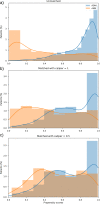Differences in cohort study data affect external validation of artificial intelligence models for predictive diagnostics of dementia - lessons for translation into clinical practice
- PMID: 32843907
- PMCID: PMC7429672
- DOI: 10.1007/s13167-020-00216-z
Differences in cohort study data affect external validation of artificial intelligence models for predictive diagnostics of dementia - lessons for translation into clinical practice
Abstract
Artificial intelligence (AI) approaches pose a great opportunity for individualized, pre-symptomatic disease diagnosis which plays a key role in the context of personalized, predictive, and finally preventive medicine (PPPM). However, to translate PPPM into clinical practice, it is of utmost importance that AI-based models are carefully validated. The validation process comprises several steps, one of which is testing the model on patient-level data from an independent clinical cohort study. However, recruitment criteria can bias statistical analysis of cohort study data and impede model application beyond the training data. To evaluate whether and how data from independent clinical cohort studies differ from each other, this study systematically compares the datasets collected from two major dementia cohorts, namely, the Alzheimer's Disease Neuroimaging Initiative (ADNI) and AddNeuroMed. The presented comparison was conducted on individual feature level and revealed significant differences among both cohorts. Such systematic deviations can potentially hamper the generalizability of results which were based on a single cohort dataset. Despite identified differences, validation of a previously published, ADNI trained model for prediction of personalized dementia risk scores on 244 AddNeuroMed subjects was successful: External validation resulted in a high prediction performance of above 80% area under receiver operator characteristic curve up to 6 years before dementia diagnosis. Propensity score matching identified a subset of patients from AddNeuroMed, which showed significantly smaller demographic differences to ADNI. For these patients, an even higher prediction performance was achieved, which demonstrates the influence systematic differences between cohorts can have on validation results. In conclusion, this study exposes challenges in external validation of AI models on cohort study data and is one of the rare cases in the neurology field in which such external validation was performed. The presented model represents a proof of concept that reliable models for personalized predictive diagnostics are feasible, which, in turn, could lead to adequate disease prevention and hereby enable the PPPM paradigm in the dementia field.
Keywords: Alzheimer’s disease; Artificial intelligence; Bioinformatics; Cohort comparison; Cohort data; Data science; Dementia; Digital clinic; Disease modeling; Disease risk prediction; Health data; Individualized patient profiling; Interdisciplinary; Machine learning; Medical data; Model performance; Model validation; Multiprofessional; Neurodegeneration; Precision medicine; Predictive preventive personalized medicine (3 PM/PPPM); Propensity score matching; Risk modeling; Sampling bias; Survival analysis; Translational medicine.
© The Author(s) 2020.
Conflict of interest statement
Conflicts of interestsThe authors declare that they have no conflict of interest.
Figures



References
-
- Prince MJ, Guerchet M, Prina M. The Global Impact of Dementia 2013-2050: Policy Brief for Heads of Government. Alzheimer's Dis Int. 2013.
-
- Wimo A, Jönsson L, Bond J, Prince M, Winblad B, International AD The worldwide economic impact of dementia 2010. Alzheimers Dement. 2013;9(1):1–11. - PubMed
-
- Folch J, Busquets O, Ettcheto M, Sánchez-López E, Castro-Torres RD, Verdaguer E, Garcia ML, Olloquequi J, Casadesús G, Beas-Zarate C, Pelegri C, Vilaplana J, Auladell C, Camins A. Memantine for the treatment of dementia: a review on its current and future applications. J Alzheimers Dis. 2018;62(3):1223–1240. - PMC - PubMed
-
- Livingston G, Sommerlad A, Orgeta V, Costafreda SG, Huntley J, Ames D, Ballard C, Banerjee S, Burns A, Cohen-Mansfield J, Cooper C, Fox N, Gitlin LN, Howard R, Kales HC, Larson EB, Ritchie K, Rockwood K, Sampson EL, Samus Q, Schneider LS, Selbæk G, Teri L, Mukadam N. Dementia prevention, intervention, and care. Lancet. 2017;390(10113):2673–2734. - PubMed
LinkOut - more resources
Full Text Sources

